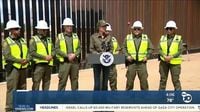In a move that has reignited the national debate over border security and migration policy, U.S. Homeland Security Secretary Kristi Noem announced this week that the entire U.S.-Mexico border wall will soon be painted black—a strategy directly requested by President Donald Trump. The announcement, made from a sun-baked stretch of the wall in New Mexico on August 19, 2025, marks the latest chapter in the Trump administration’s ongoing efforts to deter illegal border crossings and reinforce the southern barrier.
Standing alongside Customs and Border Protection officials, Secretary Noem didn’t just talk about the plan—she picked up a roller and helped paint a section of the wall herself. "We are going to be painting the entire southern border wall black to make sure that we encourage individuals to not come into our country illegally," Noem declared, as reported by Fox 5 San Diego. She explained the rationale in straightforward terms: "When you touch something that is hot during these kinds of temperatures, it is very difficult to climb it, to touch it, to handle it."
The black paint, officials say, will cause the metal wall to heat up rapidly under the desert sun, making it painful for anyone who tries to scale it. President Trump, who initially floated the idea during his first term in office, believes this simple application of physics could serve as a potent deterrent. "This isn’t just a wall anymore — it’s a passive security system, using the laws of physics as defense," one supporter wrote on social media, echoing the enthusiasm of Florida radio personality Eric Daugherty, who called the plan "brilliant."
But not everyone is convinced. Critics, like Pedro Ríos of the American Friends Service Committee, question the effectiveness and humanity of the measure. In an interview with Fox 5 San Diego, Ríos pointed out, "We don’t know how many people are climbing the border wall, but we do usually see … ladders thrown about." He argued that smuggling networks are resourceful and would likely adapt, perhaps by providing gloves to those attempting to cross. More broadly, Ríos urged a shift toward policies that respect the humanitarian rights of migrants: "How do we create mechanisms [to ensure] that people’s humanitarian and human rights are respected and not cause conditions that will create greater harm and suffering for people?"
Despite such skepticism, the Trump administration is forging ahead. The plan to paint the wall black isn’t entirely new. During Trump’s first term (2017-2021), the idea was tested using coal tar epoxy coatings on select sections, but was ultimately shelved in 2020 after U.S. Customs and Border Protection (CBP) determined it would add about $1 million per mile to the project’s cost. Now, with new resources at their disposal, the administration is reviving the strategy—and on a far grander scale.
Just one month ago, President Trump signed the One Big Beautiful Bill Act, which earmarked $46.5 billion of the Department of Homeland Security’s $165 billion budget specifically for border wall construction. According to Secretary Noem, this infusion of funding is allowing construction to proceed at a pace of "a little bit less than a half a mile a day." The wall’s design, she noted, will continue to vary depending on the local geography and topography—an acknowledgment of the complex and often rugged terrain along the nearly 2,000-mile southern border.
In addition to the black paint, Noem announced that the Department of Homeland Security is ramping up technological enhancements along the border. "Technology, cameras, sensors" will be added to the wall to further strengthen its effectiveness, she said during her press conference in Santa Teresa, New Mexico. These upgrades are part of a broader push to modernize border security systems and reduce reliance on physical barriers alone.
U.S. Border Patrol Chief Mike Banks, who attended the New Mexico event with Noem, offered another practical justification for the paint job. Beyond deterring climbers, he said, the black paint would help "deter rust, extending the life expectancy of the wall." Given the harsh conditions the wall endures—from scorching summer heat to monsoon rains—maintenance is no small concern.
The administration is also exploring additional "waterborne infrastructure" along the Rio Grande, which forms more than half of the U.S.-Mexico border. These initiatives aim to address the unique challenges posed by river crossings and fluctuating water levels, further complicating any attempts to breach the barrier.
All of this comes at a time when illegal border crossings have reportedly dropped significantly. Still, the Trump administration is pushing to complete the wall and implement new deterrence measures, arguing that border security remains a top national priority. The painting project, while symbolically potent, is just one facet of a sprawling and expensive effort to reshape America’s approach to its southern frontier.
The cost and timeline for painting the entire wall remain unclear. The first Trump administration completed 452 miles of border wall before construction was paused by President Joe Biden in 2021. After a legal battle, the Biden administration was ultimately compelled to fill in certain gaps using previously appropriated funds. Now, with Trump back at the helm and fresh funding secured, the push to finish—and now paint—the wall is back in full swing.
Supporters of the black paint plan see it as a creative, cost-effective way to leverage natural conditions for security. Critics, meanwhile, argue that it’s a superficial fix that fails to address the complex root causes of migration. As with so many aspects of U.S. immigration policy, the debate is as much about symbolism and politics as it is about practical outcomes.
One thing is certain: the border wall, already a flashpoint in America’s political landscape, is once again at the center of a heated national conversation. Whether painting it black will actually deter would-be climbers—or simply add another layer to the ongoing debate—remains to be seen. But for now, the brushstrokes of policy and politics are as bold as ever along the southern border.

